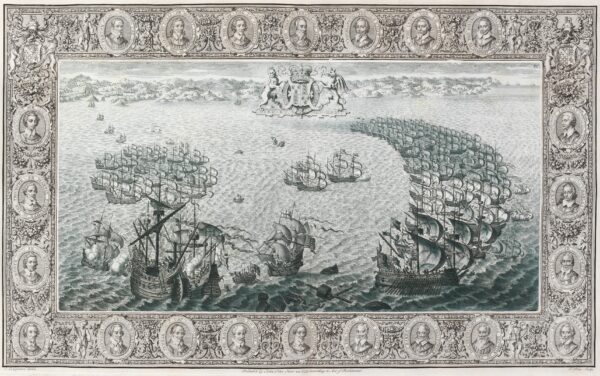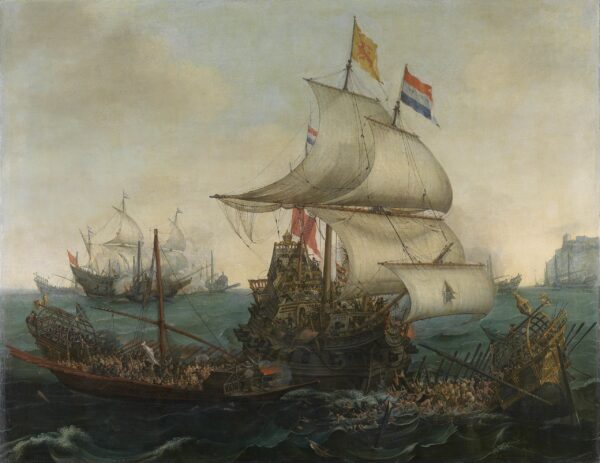


Under a gray sky, a heavily armed Dutch cargo ship powers through the choppy waters of the North Sea, in Hendrick Cornelisz Vroom’s painting “A Fleet at Sea.” Wind fills the ship’s sails. Sailors work hard, ensuring that the ship stays on course. High on the mast a golden flag with a red lion motif flutters in the breeze, announcing that this ship comes from the province of Holland, and that it likely was the Roode Leeuw (Red Lion) that set sail for the Caribbean and South America in 1597.
At the heart of the red, white, and blue Dutch flag that flies on the stern pole is Rotterdam’s municipal crest, hinting at the ship’s home port.
The port of Den Briel, in the west Netherlands, can be seen in the distance, where the Maas River widens to the North Sea.
We may recognize the ship’s silhouette as similar to the Mayflower, which brought the Pilgrims to Cape Cod on Nov. 21, 1620. Both ships were “fluyts,” Dutch cargo ships. Fluyts are pear-shaped like Spanish galleons, and have square rigs with two or three masts. The fluyt design originated in the 16th century and was created to maximize cargo space and crew efficiency.
In October 2022, the National Gallery of Art acquired Vroom’s “A Fleet at Sea” painting.
As the first Dutch painter to specialize in seascapes, Vroom deftly painted ship portraits and epic sea-battle scenes teeming with action. Indeed, he popularized such paintings. And, according to the gallery’s press release, “Vroom paved the way for later 17th-century marine painters.”
Ship owners, captains, and shareholders of the Dutch East and West India Companies commissioned Vroom’s paintings, many of which glorify the Dutch Golden Age, showing Dutch naval and merchant might.
Some of Vroom’s paintings highlight England’s maritime might, such as when the lord admiral commissioned him to create a series of cartoons (preparatory drawings), for now-lost tapestries, celebrating England’s victory over the Spanish Armada in 1588. The tapestries were displayed in the House of Lords until a fire destroyed the textiles in 1834.
Vroom managed to create harmonious paintings even when depicting battles or powerful sea surges.
Born in Haarlem in the province of North Holland, Vroom first became a pottery and faience (tin-glazed pottery) painter, loosely following in the footsteps of his father, who was a sculptor and ceramic artist.
When he was 19 years old, he boarded a ship to Spain, then Italy. Of note, in Florence between 1585 and 1587, the Medici family became his patrons. Traveling through Italy and France, he painted pottery, studied under Flemish landscape painter Paul Bril, and met artists such as Haarlem painter Jan Kraeck, (a court painter for the House of Savoy in Turin, Italy), gaining much inspiration for his art.
Vroom also had some adventures. On one voyage to Seville, in Spain, he became shipwrecked in Lisbon, Portugal. The natives wanted to kill the crew, thinking them to be pirates. After Vroom showed the natives some of his small religious paintings, the natives were convinced that the crew were Christians and spared their lives.
As a seasoned sailor, Vroom understood the sea elements: how the wind, water, and sunlight behaved in all kinds of weather. Having spent countless hours on the water, he knew how to render every last detail of a sailor’s work and the ship’s architecture.
His lively, vibrant seascapes remain as testimonies of when the sails ruled the high seas, and distant lands were sailors’ dreams.


